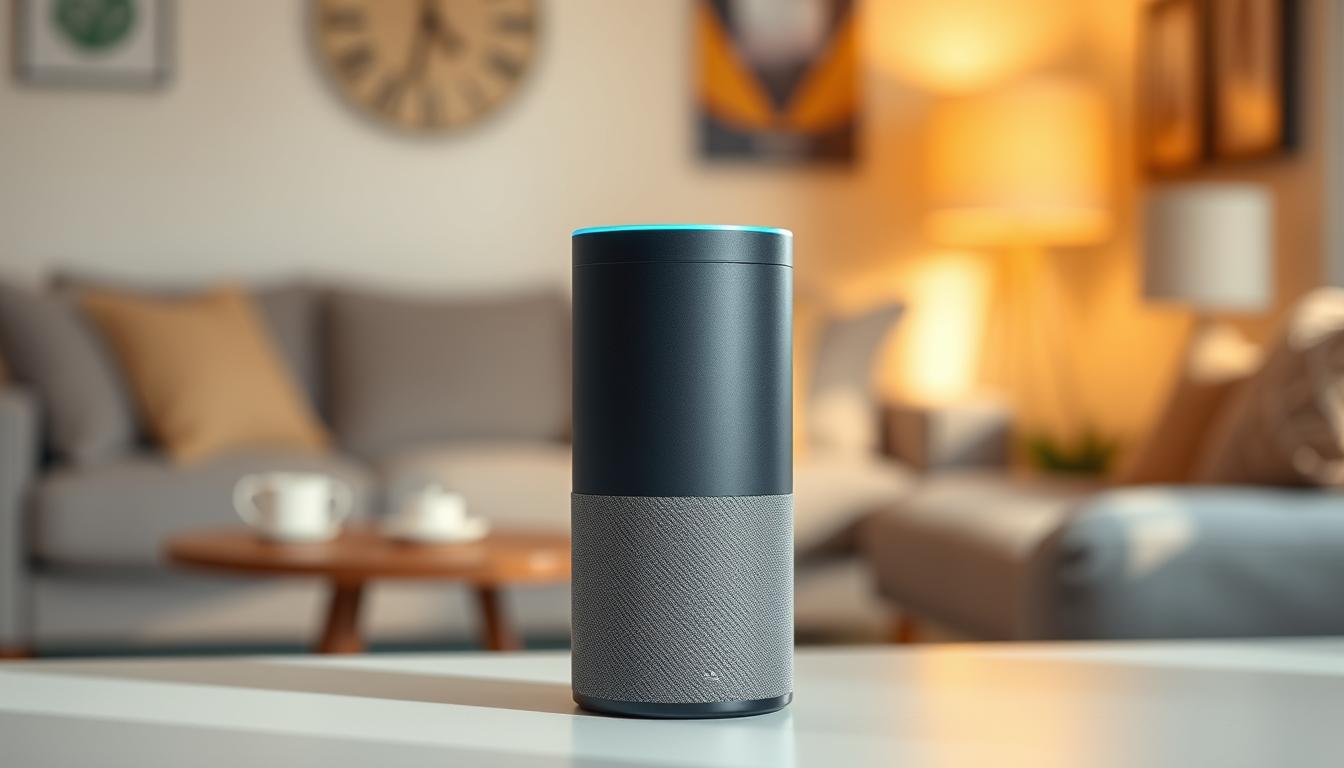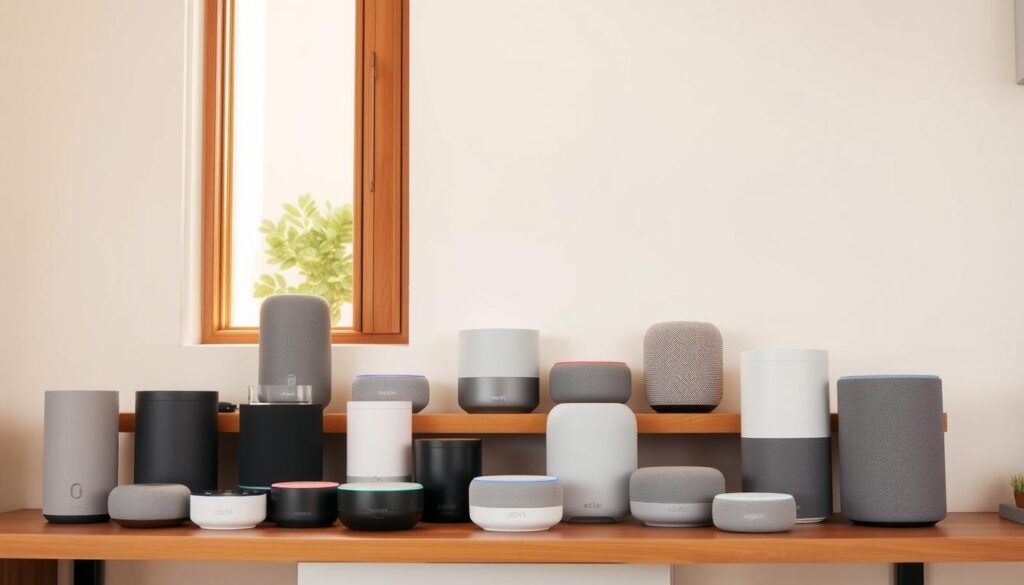Discover Amazon Echo 4th Gen: Features, Specs, and More

The Amazon Echo (4th Gen) brings a round, fabric-wrapped design that fits neatly in the living room. It ships in Charcoal, Glacier White, and Twilight Blue and aims to blend with home decor.
As a smart home device, it connects via Wi‑Fi, Bluetooth 5.0, and Spotify Connect. Setup is simple through the Alexa app on iOS and Android, enabling multi-room audio, EQ tweaks, alarms, and extra skills.
The speaker hardware pairs dual 20mm tweeters with a 76mm neodymium woofer for punchy bass and smooth highs. Physical controls sit on top, while an LED ring at the base shows status—blue for listening and red for mute.
It is not portable and needs constant AC power via a 30W adapter, but offers an aux input and a threaded base mount for flexible placement. Integrations with Ring and Zigbee make it a practical hub for a smart house.
Amazon Echo 4th Gen at a glance: who it’s for right now
This compact smart speaker targets buyers who already use Alexa, Ring, or Zigbee gear and want a better low end without a separate subwoofer.
Commercial intent: Shoppers choose this model for its hub-like smart home control, broad streaming support (Spotify Connect, Apple Music, Pandora, Tidal), and consistent connectivity via Wi‑Fi and Bluetooth 5.0.
Key reasons shoppers choose this speaker
- Works well within a smart home and controls Ring devices and Zigbee lights.
- Stronger bass than many compact units, making it a good mid-size audio upgrade.
- Aux input and wider service support set it apart from the echo dot siblings.
- Typical MSRP around $99, with speaker price often dropping near Prime Day to under $60.
Quick pros and watch-outs from real testing
Pros: Smooth setup, reliable voice control, and solid value when on sale. It doubles as a smart-home hub and plays many streaming services.
Watch-outs: It must stay plugged in and favors bass tuning, which can mask mids at high volume. YouTube often needs third-party skills or workarounds.
| Feature | Why it matters | Compare |
|---|---|---|
| Smart home hub | Controls Ring, Zigbee lights, routines | Better than many compact devices |
| Aux input | Wired source support | Not available on echo dot models |
| Price | Frequent discounts improve value | Often cheaper on Prime Day |
Design and build: spherical style, colors, and footprint
The speaker’s spherical shell and fabric finish make it read more like decor than a piece of tech. At 986g the orb feels solid but compact enough for side tables and TV stands. It looks like a tidy accent rather than a bulky box.
Charcoal, Glacier White, and Twilight Blue fabric finish
The unit ships in Charcoal, Glacier White, and Twilight Blue, with the textile wrap giving consistent surface quality.
Glacier White and Twilight Blue options help it blend into light or dark rooms while signaling the amazon echo styling.
Buttons, LED light ring on the bottom, and that white power cable
Four controls sit on the top: an action button, mute, and volume up/down for quick tweaks.
The slim LED ring runs along the bottom, casting subtle lights—blue while listening, red when muted—without being distracting.
Power and aux ports are tucked at the back to keep cables tidy, though the included white power cable can contrast with darker finishes. Tests show best sound dispersion when the speaker sits low on a shelf or table rather than high up.
Setup and the Alexa app experience
Setting up the speaker takes just minutes and the companion app walks users through each step.
First-time setup is simple: plug the unit in, open the alexa app on iOS or Android, and follow prompts to connect the 4th gen to Wi‑Fi and your account. The app guides Bluetooth pairing, renaming the device, and adding another speaker or a subwoofer.
Making follow-up requests and multi-room groups
Enable Follow-up Mode in device settings to ask consecutive questions without repeating the wake word. This makes it easier when you call alexa and want to keep the conversation flowing.
The app also handles multi-room groups, EQ adjustments, alarms, and skills. Users can create stereo pairs, set aux as input or output, and group devices so music plays in sync across rooms.
| Action | Where | Result |
|---|---|---|
| Connect to Wi‑Fi | alexa app → Add Device | Online and ready to play music |
| Enable Follow-up | Device Settings | Consecutive voice requests work |
| Create multi-room | Groups → Create Group | Sync playback across devices |
Tip: Use Spotify Connect from the Spotify app for direct control, or stream Amazon Music, Apple Music, Pandora, Tidal, and others via the app. The app also manages skills and permissions so the amazon alexa ecosystem lets control smart home gear and routines reliably.
Controls, LEDs, and everyday use
Everyday interactions happen on the speaker’s crown, where tactile keys handle volume, actions, and privacy fast.
Action, volume, and mute button with red LED privacy cue
The top hosts a tactile action button, physical volume up/down, and a clear mute button for instant privacy. These keys keep common commands within reach and reduce app dependence.
The slim led ring communicates status at a glance. It glows blue when the device is listening and shows a red led light when the mic is disabled.
Users who avoid voice control can press the action button to trigger queries without the wake word. With the mic muted, the unit still works as a streaming speaker via Bluetooth or Spotify Connect.
“A visible red light gives immediate confidence that the microphone is off.”
- Top layout keeps controls handy for quick volume and timers.
- Subtle lights remain readable without being distracting.
- Continuous power means the device resumes quickly after outages.
| Control | Indicator | What it does |
|---|---|---|
| Action button | None | Triggers interactions without saying the wake word |
| Volume up/down | None | Adjusts playback level immediately |
| Mute button | Red light | Disables mic while keeping streaming active |
| LED ring | Blue / Red | Shows listening or privacy status |
Connectivity and smart home compatibility
Users will find fast pairing options and hub features that work with common smart home gear.
The 4th gen supports Wi‑Fi streaming, Bluetooth 5.0 pairing, and Spotify Connect for direct control from the Spotify app. An aux jack is available and can be set as input or output inside the app. That flexibility lets the speaker link to legacy gear or feed another powered speaker.
Setup flow in the alexa app
Setup is guided in the alexa app: open the app, tap Devices, press +, choose Add Device, pick the category, and follow prompts. The process discovers compatible home devices and adds them to groups for multi-room audio.
Mounting, power, and smart home links
A threaded mount on the bottom fits standard stands. The power input sits at the back for neater cable runs. Once installed, the unit can control Ring doorbells and Zigbee lights, reducing the need for extra hubs.
| Connection | Benefit | Use case |
|---|---|---|
| Wi‑Fi | Stable streaming | High-quality playback over home network |
| Bluetooth 5.0 | Quick guest pairing | Play from phones without the app |
| Spotify Connect | Direct control | Use Spotify app to manage playback |
| Aux (switchable) | Legacy support | Connect CD players or external amps |
“Grouping devices in the app makes expanding a multi-room setup simple.”
Audio hardware and tuning: what drives the sound
A compact design masks a focused audio strategy. The 4th gen speaker pairs purpose-built drivers with smart tuning to deliver a full, warm sound for everyday listening.
Driver array and physical layout
The driver array uses dual 20 mm tweeters and a 76 mm neodymium woofer. This combination gives clear highs and a punchy low end from one enclosure.
Loudness behavior and EQ controls
Measurements show an internal loudness contour. At low volume the system slightly boosts bass. As volume rises, bass emphasis eases to avoid overload.
For clean playback, keep volume near 4–7 out of 10. Above level 8, distortion and output compression increase.
EQ in the app lets users raise treble and mids to restore vocal detail. One common tweak is Treble +3 and Mids +1 for clearer balance without harshness.
| Spec | Behavior | Practical tip |
|---|---|---|
| Driver array | Dual tweeters + 76mm woofer | Full-range from one speaker |
| Bass tuning | Boosted at low volume, reduced at high | Keep volume 4–7 for control |
| Frequency response | Elevated lows, slightly recessed mids | Use EQ to add mids/treble |
“The tuning favors a warm, bass-forward signature that adapts well with simple EQ changes.”
Sound quality review and frequency response insights
Listeners will notice a clear low-frequency push that gives pop and electronic tracks extra weight. The 4th gen tuning places emphasis between roughly 40–100 Hz, which makes bass feel full without requiring a subwoofer.
Frequency response shows a dip through the midrange. That dip can make vocals and acoustic guitars sound a bit recessed compared with the google nest, which tends to bring mids forward.
Highs remain smooth and rarely harsh, even at higher volume. Cymbals and hi-hats are present but have less reverb tail than on more neutral models.
Listening notes and practical tips
In real rooms the speaker projects a warm, enveloping character. A small mid or treble lift in the app restores vocal clarity for podcasts and folk music.
- Bass is forward (40–100 Hz) — great for beats and synths.
- Mids sit back a bit versus google nest, so vocals may need EQ.
- Highs stay controlled at common listening volume, avoiding fatigue.
“A fun, bass-tilted choice that rewards modern playlists while letting EQ fix vocal balance.”
Measured performance and distortion notes
Measured output shows how the 4th gen handles real listening. Tests with a MOTU M4 and ECM999 mic expose the unit’s internal loudness control and its trade-offs for clean playback.
THD and output behavior at moderate vs. high volume
Objective tests indicate best quality between volume levels 4–7. Below that range the system boosts bass a bit to improve presence. Above level 8 the speaker compresses and distortion rises.
- THD: ~0.96% at 1 kHz, ~2% at 100 Hz, <2% at 10 kHz, slightly over 3% at 16 kHz.
- IMD appears with combined 60 Hz and 7 kHz tones, so critical listening should avoid max loudness.
- Aux output measures ~0.9V RMS at 80% volume—suitable for many powered inputs but not a pro line level.
Placement matters: table or bottom shelf for better dispersion
Placement improves perceived frequency response and sound staging. Sitting the unit on a table or bottom shelf helps dispersion and adds bass energy.
“Mounting higher than about 1 meter narrows the tweeter dispersion and thins mids.”
| Setting | Benefit | Tip |
|---|---|---|
| Table / bottom shelf | Better dispersion | Use at ear level when seated |
| High placement (>1 m) | Narrower treble | Can reduce vocal clarity |
| Mid volume (4–7) | Best balance | Limits compression and keeps clarity |
Microphones, voice control, and privacy
The microphone array on the 4th gen handles far-field pickup well, so voice commands register over typical background music. It catches short requests like volume changes and timers even when tracks play at moderate to high levels.
Voice pickup with music playing and supported services
The mic stays responsive across living rooms and open-plan spaces. Voice control works with common services and smart home platforms, including smart lights and streaming systems via the amazon alexa ecosystem.
Mute behavior, red LED, and what still works with mic off
Pressing the mute button disables the mic entirely and makes the led light glow red so everyone sees that voice capture is off.
While muted the device still has full audio power for Bluetooth and Spotify Connect, so it functions as a regular powered speaker without voice features.
“Physical controls and a visible red ring make privacy modes clear for all users.”
- Capability note: routines and announcements pause when the mic is off.
- Visual cues—blue when listening, red when muted—help multi-user homes avoid confusion.
- Privacy-minded users can rely on the hardware switch and local indicators alongside app settings.
Smart home device control and ecosystem fit
This speaker doubles as a centralized hub that unifies cameras, lights, and automations across a modern house. It links Ring cameras and Zigbee-compatible lights so the user can manage many home devices from one place.
Using Alexa routines with Ring, Zigbee-compatible devices, and lights
Routines let the system run multi-step actions automatically. For example, a morning routine can turn on Zigbee lights, announce the weather, and play an amazon music playlist.
The setup workflow is simple: open the Devices tab in the app, tap Add Device, pick the category, and follow the prompts. Devices appear by room so the user can group alexa devices for synchronized control and announcements.
When Alexa skills are needed for media like YouTube
Some services, notably YouTube, often depend on third-party skills or integrations to work smoothly. Once those skills are enabled, voice control to play music or video becomes seamless.
- Practical hub: Connects Ring cameras, Zigbee lights, and other smart home devices via guided setup.
- Routines: Automate scenes, schedules, and conditional actions for mornings, evenings, and away modes.
- Multi-room: Group alexa devices to play music across the house and send announcements to specific rooms.
“Adding devices is quick through the Devices tab and Add Device flow, which keeps expanding ecosystems manageable.”
amazon echo 4th gen price, value, and Prime Day deals
Deep discounts during shopping events often change the value equation for this model. Typical retail price sits near $99, and it ships with a power adapter in Charcoal, Glacier White, and Twilight Blue.
Typical pricing, promotions, and how it stacks up on value
Street trends keep the speaker price competitive. On Prime Day it dropped to about $59, which shifts the comparison against the Echo Dot options.
The unit offers aux in/out, Spotify Connect, and multi-service support via the companion app. Those extras raise real-world value beyond the sticker.
- At MSRP: good feature set for $99.
- At sale price: exceptional value for music and smart home control.
- Ownership: includes adapter and simple setup, so few hidden costs.
| Price tier | Typical street price | Value takeaway |
|---|---|---|
| MSRP | $99 | Balanced feature set for many homes |
| Major sale | $59 (Prime Day) | Best price-to-feature ratio |
| Budget alternative | Echo Dot lower cost | Smaller drivers, no aux input |
“Timing a purchase around major sales yields the strongest value for buyers.”
Alternatives to consider: Echo speakers and competitors
A two-tier plan works well: a main, full-range speaker in shared space and compact units for bedrooms and kitchens.

Echo Dot (5th Gen) vs Echo 4th Gen: aux input and sound trade-offs
The echo dot is smaller and cheaper but lacks an aux input and the fuller low end of the larger unit.
Good for: tight budgets and basic voice tasks. Not ideal if aux or thicker bass matters.
Echo Pop for tight spaces and budgets
The Pop targets very small rooms. It is affordable and easy to place but won’t reach the same loudness or bass weight.
Google Nest Audio and Apple HomePod mini options
Google Nest emphasizes clearer mids and Google Assistant ties. HomePod mini shines with AirPlay 2 and Apple ecosystem features.
Portable pick: Sonos Roam 2 with Wi‑Fi and Bluetooth
Sonos Roam 2 adds real portability, IP67 protection, and Sonos app support—handy for patios and travel.
| Model | Strength | Best for |
|---|---|---|
| Echo 4th Gen | Full bass, aux | Main living room |
| Echo Dot | Small, cheap | Bedrooms, secondary rooms |
| Google Nest | Clear mids | Google service users |
| Sonos Roam 2 | Portable, rugged | Outdoors, travel |
“Use a main speaker as the anchor and smaller units to fill the house for best value.”
Final take: is this the smart home speaker to buy today
Buyers will find a useful mix of stronger low end and broad smart home integration in this 4th gen review. The unit raises perceived quality without adding complexity.
The amazon echo acts as a central smart home device, ties into Ring and Zigbee, and keeps setup simple. It needs AC power and is not portable, but privacy is clear with a hardware mute and red LED.
Sound favors warmth and bass, yet EQ options restore vocal detail. With frequent sales, the asking price often lands it among the best buys for an everyday speaker.
Verdict: recommend it for most homes that want tidy integration, solid sound, and reliable smart home control.



